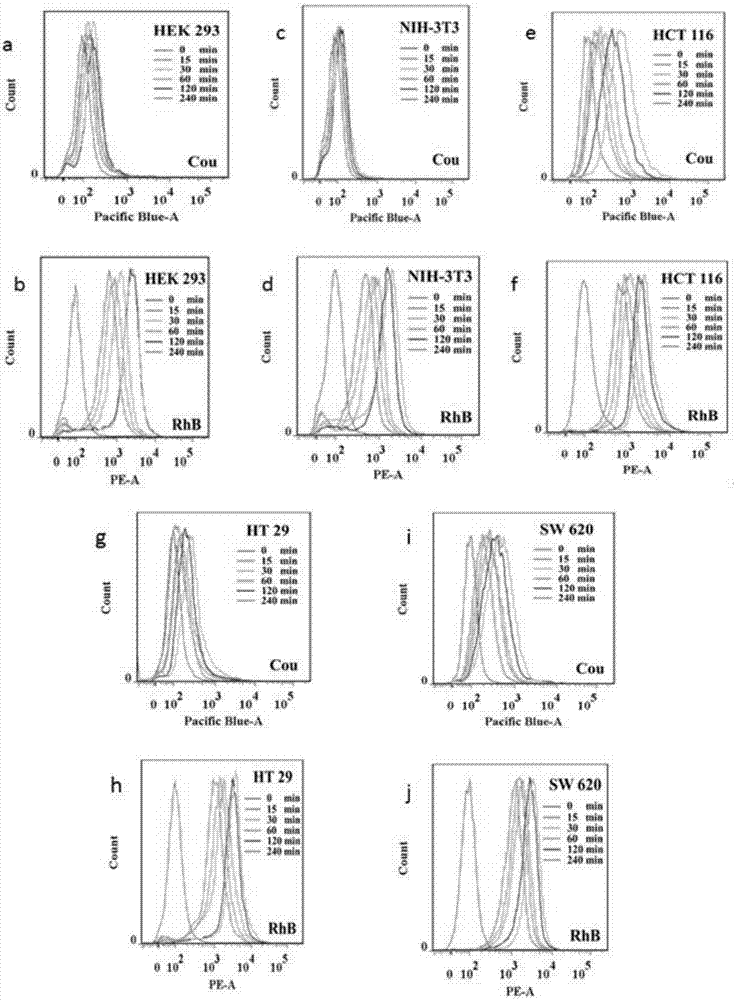Hydrogen peroxide responsive ratio meter nanoprobe and its use
A technology of hydrogen peroxide and nano-probes, applied in chemical instruments and methods, material analysis through optical means, instruments, etc., can solve the problems of insufficient sensitivity or specificity, and achieve easy cytotoxicity, excellent fluorescence performance, good The effect of water solubility
- Summary
- Abstract
- Description
- Claims
- Application Information
AI Technical Summary
Problems solved by technology
Method used
Image
Examples
Embodiment 1
[0027] Example 1. Synthesis, assembly and characterization of ratiometric nanoprobes
[0028] Dissolve succinimide-activated-coumarin-phenylboronic acid pinacol ester (62.6mg, 0.125mmol) and isothiocyanate-activated rhodamine B (6.65mg, 0.0125mmol) in dimethylmethylene Sulfone (DMSO), was added dropwise to an aqueous solution of ethylene glycol chitosan (160 mg, 0.75 mmol), and finally 20 μL of triethylamine was added, and reacted at room temperature for 24 h. After the reaction, first in DMSO / H 2 Dialyzed in O(1 / 4, V / V) for 48h, and then dialyzed in ultrapure water for 48h, assembled to obtain the ratiometric nanoprobe (GC-Cou-Bpin-RhBnanoprobe), figure 1 .
[0029] The chemical structure of the ratiometric nanoprobe was characterized by NMR spectroscopy, as figure 2 (a) 1 As shown in the H NMR spectrum, the characteristic peaks of two fluorescent molecule benzene rings appeared at 6.5-8.0ppm, and the characteristic peaks of the methyl group on phenylboronic acid pinacol...
Embodiment 2
[0031] Embodiment 2. Experiment of colon cancer cell line
[0032] We selected two normal cells (HEK 293 and NIH-3T3) and three colon cancer tumor cells (HCT 116, HT 29 and SW620) and characterized GC-Cou-Bpin-RhB by flow cytometry and confocal laser Intracellular Capability of Ratiometric Nanoprobes and Detection of H in Cells 2 o 2 content. Analyze flow cytometry results from different cell lines such as image 3 As shown, according to the fluorescence intensity of the internal standard RhB, we found that both normal cells and tumor cells can enter the ratiometric nanoprobes to varying degrees. The cell entry ability of colon cancer cell HCT 116 was similar to that of normal cell HEK 293, but the H in HCT116 cells 2 o 2 The concentration is much higher than that of HEK 293. As for the colon cancer cell HT29, its ability to enter cells is stronger than that of the other two colon cancer cells HCT 116 and SW 620, but its H 2 o 2 The concentration is much lower than the...
Embodiment 3
[0035] Example 3. Ratiometric nanoprobes assist in the detection of CTC in patients with gastric cancer
[0036] We enriched CTCs in the peripheral blood of patients with gastric cancer by negative screening method, and used GC-Cou-RhB ratiometer nanoprobes and tumor cell surface-specific antibody cytokeratin (CK19- FITC) to stain the enriched cells together and observe with laser confocal, where the blue is H 2 o 2 The probe coumarin-phenylboronic acid pinacol ester and H 2 o 2 The fluorescence emitted after the reaction, the red fluorescence is the internal standard probe Rhodamine B, and the green fluorescence is CK19-FITC, such as Figure 7 shown. Figure 7 (27), (28), and (29) showed that although the amount of the probe entering the cell was not much (internal standard fluorescence was weak), the concentration of hydrogen peroxide in the cell was high (blue fluorescence was strong), among which Figure 7 (29) had relatively strong expression of CK-19 on the surface ...
PUM
| Property | Measurement | Unit |
|---|---|---|
| particle size | aaaaa | aaaaa |
| particle diameter | aaaaa | aaaaa |
Abstract
Description
Claims
Application Information
 Login to View More
Login to View More - R&D
- Intellectual Property
- Life Sciences
- Materials
- Tech Scout
- Unparalleled Data Quality
- Higher Quality Content
- 60% Fewer Hallucinations
Browse by: Latest US Patents, China's latest patents, Technical Efficacy Thesaurus, Application Domain, Technology Topic, Popular Technical Reports.
© 2025 PatSnap. All rights reserved.Legal|Privacy policy|Modern Slavery Act Transparency Statement|Sitemap|About US| Contact US: help@patsnap.com



